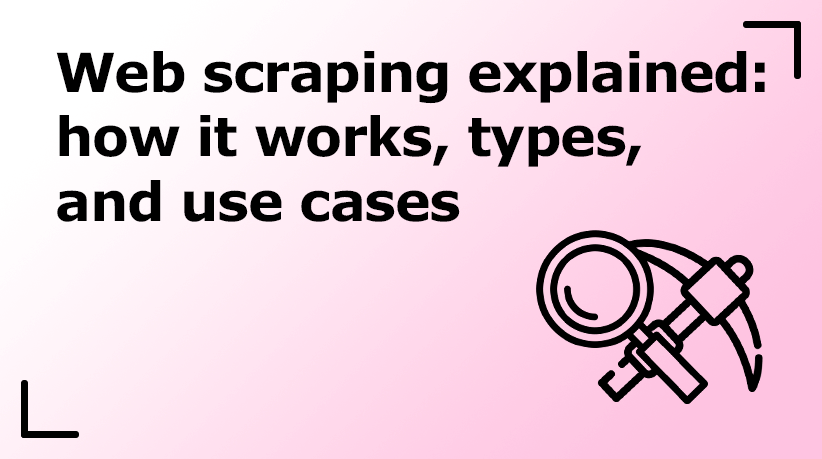Forward Proxies Explained: A Complete Beginner Guide
Using proxy servers is easily one of the most effective ways to browse the internet securely without worrying about being tracked by the sites you access. ProxyWing offers different types of proxies, including forward proxy solutions that you can rely on to privately browse the internet. By hiding your devices behind forward proxies, you effectively access internet services privately without compromising network performance.
Article’s Key Takeways
- Forward proxies mask client IPs to enhance privacy, security, and browsing control.
- They can filter traffic, block access to unwanted sites, cache frequently visited pages for faster loading, and even bypass geo-restrictions, making them useful for individuals, organizations, and researchers.
- Unlike reverse proxies, which protect servers, forward proxies focus on hiding client identities and managing outbound requests.
- While they provide benefits like improved security, ad verification, and productivity management, they also come with drawbacks such as possible slowdowns, blocked access by certain sites, or risks from untrusted providers.
- Ultimately, forward proxies are a powerful tool for safer, more flexible internet usage, but their effectiveness depends heavily on correct configuration and reliable providers.
- ProxyWing forward proxies combine speed and affordability – perfect for streaming, browsing, or business.
If you are keen to learn more about forward proxies, but not sure if they are worth the cost, this article is for you. In this article, I will do my best to explain everything you may need to know about forward proxies, including how they work, use cases, benefits, and more. So, without wasting any more of your time, let’s dive right in. To ensure we are all up to speed, we will start with the fundamentals of forward proxies.
What is a Forward Proxy?

A forward proxy is a server that sits in front of a client (such as your computer or phone)—it acts as an intermediary between the client and online servers. That means every time a user tries to browse the internet, their connection is routed through the proxy server before being sent to any website or web application they are trying to use. So, the final IP addresses that the websites the user tries to access will be that of the proxy server or proxy network instead of the device.
Privacy and security solutions like forward proxies can be used by both individuals and organizations who need more secure web access. For instance, an organization could use a forward proxy to ensure that all devices in their network connect to the public internet using the same IP address. A forward proxy also secures web access by hiding the user’s location. All this is done by proxy providers behind the scene without the user noticing.
How Does a Forward Proxy Work?
When you have a forward proxy in front of clients, all the network traffic from these devices goes through it before being sent to the internet. Once the proxy receives the traffic, it will then redirect it to the target website or web app that the user intended to access. After processing the request, the website will now send the response to the IP address of the proxy, which then forwards it to the IP address of the target device that initiated the request.
Forward proxies can also be configured with rules to block traffic if it violates certain pre-determined conditions. For instance, an organization may want to restrict their users from accessing social media sites during work hours. So, if any device tries to connect to a website like Instagram, the proxy might block this connection if it is triggered during work hours.
Forward Proxy vs. Reverse Proxy
Here is a summary of the differences between forward and reviver proxies
| Feature | Forward Proxy | Reverse Proxy |
| Privacy | The goal of this proxy is to hide the client’s IP address from websites. This ensures the user browses the internet anonymously. A forward proxy distributes network traffic coming to it based on the IP that made the request. | With reverse proxies, the goal is to hide a server’s IP address from the public internet. That means all requests and responses of a server having a reverse proxy will use this proxy’s IP address |
| Security | Using a forward proxy can block malicious websites from tracking your browsing patterns to potentially target you with malware. | It helps protect the server by shielding it from any malicious requests. Reverse proxies can also be used to handle TLS/SSL. |
| Performance | A forward proxy can cache the most frequently accessed contents, which can effectively boost performance. | A reverse proxy can be used for distributing traffic between multiple servers behind it by accessing resources, which can improve the performance of each server. A reverse proxy can distribute content based on the health of the servers, improving network performance. |
Common Uses of Forward Proxies
- Streaming content: Users can use a forward proxy with an IP address in a non-restricted region to access blocked content on streaming sites like Netflix, addressing any limitations to their streaming experience.
- Content filters: Organizations can use a proxy to filter content before it is sent to the internet. A proxy can be configured with access controls to determine the websites and apps users can access or those they can’t.
- Ad verification: Marketers can use forward proxies with foreign IP addresses to view and analyze how ads are displayed to their target audience.
- Data scraping: Some forward proxies were designed to give users access to multiple IPs, which can help prevent IP blocks when scraping data.
- Researching: Academic and market researchers can use forward proxies with foreign IPs to access useful data on websites restricted to certain regions, providing them access to more resources.
Benefits of Using a Forward Proxy
- Improves browsing privacy and security without affecting performance.
- Forward proxies can also improve network performance by caching content from certain web pages. If a proxy detects a certain user is often using a certain webpage, they can cache its static data to improve loading speeds.
- Forward proxies improve flexibility when browsing the web by bypassing any region-centric blocks.
- They can help boost productivity in organizations by blocking access to sites like social media that often waste a team’s time.
- Forward proxies can help protect internal networks and devices since their real IP addresses are not exposed to the internet, improving security of these networks.
Potential Drawbacks and Limitations of Forward Proxies
- If not well configured, forward proxies can hinder performance, making tasks like streaming slower.
- Some web applications and websites may block access if they detect proxy usage. Using proxies that provide multiple IPs can fix this.
- Some proxies, especially the free ones, may log or even sell your data.
- If a proxy goes down, all devices depending on it may lose access to the internet.
- Some forward proxies, especially those optimized for the best performance, can be a little costly.
Forward Proxies—Final Tips
Forward proxy services are ultimately a great solution for privacy and security when browsing the internet. Hiding your real IP can save you a lot of problems, including traffic or being targeted by malicious content from sketchy websites. But like any security solutions, forward proxies may not be perfect—sometimes they could hinder performance or even be blocked if they are not well configured. You should also remember to only use proxies from trusted proxy providers like ProxyWing and choose the configuration that meets your performance needs.
Related posts


